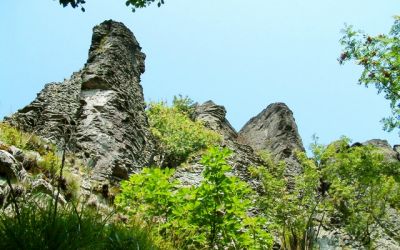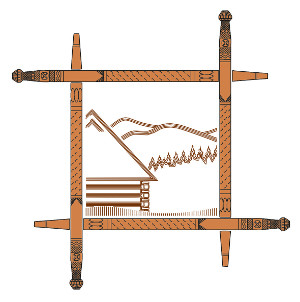WITH ART ON THE TERRACE

Opis produktu
TYPE OF THE ROUTE: car
LENGTH OF THE ROUTE: approximately 197 km
THE ROUTE:
The Dukla Pass – Medzilaborce – Snina – Humenné – Stropkov – Svidník – Przełęcz Dukielska
DESCRIPTION OF THE ROUTE:
The route starts at the Dukla Pass (500 m above sea level), it is the lowest pass in the main ridge of the Carpathian Arch. Historically, this place played an important transit role as a trade route and it was an important strategic point during World War II in 1944; the vicinity of the pass was a place of fights and burial of about 99 000 soldiers during the Prešov-Dukla operation. At present, there is a memorial commemorating soldiers who died in the fighting for the Dukla Pass. In Krajna Polana we turn to Bodružal, a village where there is a Greek Catholic church of St. Nicholas, dating from 1658, entered on the UNESCO list. Then we drive in the direction of road no. 575, where we turn east towards Medzilaborce. Along the way we pass villages, where a lot of inhabitants are Ruthenians. In Medzilaborce it is worth visiting the Andy Warhol Museum of Modern Art, where the exhibition is divided into three parts. The first exhibition is the work of Paul Warhol and his son Jacob. The second part consists of documents and props of Andy Warhol’s authentic origin, which suggest that the artist is of Ruthenian origin. The third largest exhibition area is devoted to Andy Warhol’s works. An obligatory point is also the mini open-air museum, which presents rustic villages from the past. The exhibitions are original replicas of Ruthenian houses from nearby villages. All of them are handmade.
From Medzilaborzec we head for Snina by road number 567, passing through the villages of Rusnack, on the way past Nizhna Jablonka in Hostovice we can turn left to Osandego, where there is a chapel of skulls - a crypt, in which there are remains of about 1600 Russian soldiers killed during World War I. When arriving at Snina, it is worth stopping at a classicist palace from 1781, where in the courtyard there is a statue of Hercules, which was cast from local iron. In the reconstructed palace there is currently a museum exhibition, gallery and library. Snina is a very good starting point for tourists on excursions to the Bukowe and Wyhorlat mountains, where one of the peaks of Sniński Kamień (1006 m above sea level) towers over the city. In the surrounding villages of Ruský Potok, Uličské Krivé, Topoľa and Hrabová Roztoka there are wooden Ruthenian Orthodox churches.
We drive to Humenné along the Cirocha River, in the city it is worth stopping in the Renaissance palace. The residence is guarded by four lions cast in bronze, it was built by the Drugeth family in 1610 and now there is the Wyhorlat Museum, where you can see an exhibition of the Renaissance nobility, as well as sacred art from the 20th century. Behind the palace there is an open-air museum with various folk architecture objects, such as houses, mills and blacksmith’s workshops moved from the Low Beskids, Bukowskie Mountains and Wyhoralt. The most valuable monument is the wooden church from Nowa Sedlica from 1764.
Leaving Humenné, we head for Vranov upon Toplom, after 12 km we will reach the crossroads under the ruins of Čičva Castle from the 13th century. After the invasions of Rakoczy in 1711, the castle fell into ruin. At present, you can park under the castle and take the path to the ruins, from where you can enjoy a beautiful view of the WyhorlatskéMountains. From the chateau we head towards Stropkov, we will cross the picturesque road along the Domáša reservoir, which was built in 1967. Along the way in the village of Kelča, which no longer exists, at the shore of the lagoon there is the 18th century Roman Catholic church of King Stephen built in the Baroque and Rococo style. Going further in Stropkowo we turn to Svidnik, where later we enter the main international road no. 21.
The route ends in Svidník, where it is worth stopping at the Svidník open-air museum of Ukrainian culture, where on about 10 hectares of land, objects from the culture of Ruthenians in Slovakia are gathered. These are farm buildings and artisan buildings, such as stables, granaries, barns, water mills, windmills. In addition, there is a wooden Greek-Catholic church from 1766, St. Paraskeva, which was moved from Nová Polianka. The open-air museum also has an exhibition documenting the activities of the Ruthenians, such as agriculture and pastoralism. The open-air museum area is connected with the Amphitheatre, where every year festivals related to the culture of Ruthenians are held in Slovakia, including traditional folk weddings, Easter customs, baptisms, fairs, shows of traditional folk crafts. Past Svidník we have another Ruthenian village named Ladomirová, where the Orthodox Church of St. Michael the Archangel is located, listed by UNESCO. The building dates back to 1742, has a log structure, solid oriented, covered with shingles. Inside there is a beautiful iconostasis from the eighteenth century.
Dodatkowe informacje














